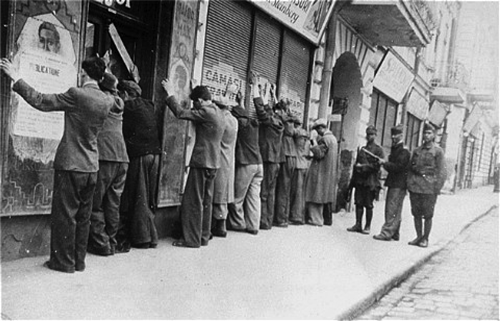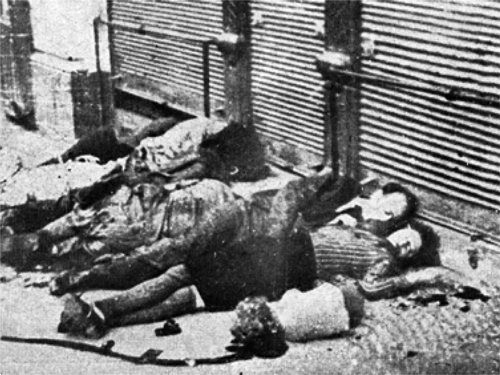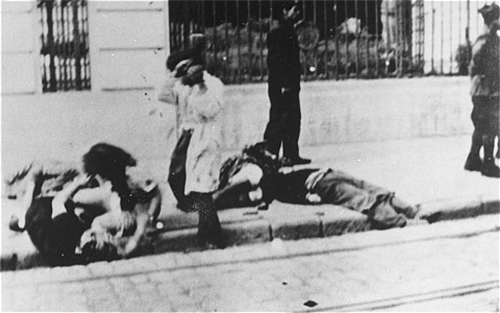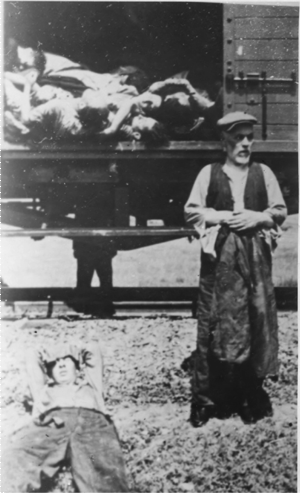|
Antisemintism, Rasism, Xenofobie
Ethics and Esthetics in Holocaust Images
Case study: the Iași Pogrom
ANCA TUDORANCEA (CIUCIU)
[The Center for the Study
of the History of Romanian Jews -
Federation of the
Jewish Communities of Romania]
Abstract:
The article refers to the negative images rediscovered in recent Romanian history, images of the Iași pogrom of June 28 to 30, 1941, that still triggers rejection reactions in different environments. The fate of these images that were to be destroyed after the event is as interesting as the recent revaluation of the data base of images, which is found today in various archives. In multiple frames civilian witnesses can be seen passing by scenes showing executions and bodies of Jewish children, women and men. Talking about the event is still rare within hours of Romanian history or public setting, often even in Iași, where many teachers prefer to talk about images related to Poland and concentration camps. Also using images from Iași pogrom without interpretations can lead in time to the same type of abuse of the image as in Auschwitz case, a negative stereotype that shows an abused victim exposed of our sight.
Keywords:
Violent images; Holocaust; Iași pogrom; Jews
Indifference and habit are dangerous things if they conceal the real moral criteria because they are the first step towards the abyss
(David Olere,
A painter in the Sonderkommando at Auschwitz).
Among the various narratives that can be constructed out of the war-time photographs, only a few of them take into consideration the author and the motive behind them. Consequently, they are used collectively (morally different images), without distinction and therefore often in combination. Thus, the capture of each photograph is essential and so is the documented context in which the photo was taken, if such a thing is possible.
The lynching of thousands of Jewish civilians is a powerful statement at the moment Romania entered World War II, and the visual demonstration of this crime is close to the Nazi propaganda which sought to desecrate the victim. The fact that these photographs exist can be compared in terms of demonstration and significance to the famous Auschwitz Album the photographs of which were taken by a member of the Nazi selection team at Auschwitz – Birkenau camp that later on turned into an exhibit for the Prosecution.
The negative images are mentioned today when speaking about the influence of the mass media, but evil as such is obviously inborn and stimulated by certain triggers. During World War II, the images used as proof of the degradation of the inferior races were provided first of all by the Nazi official press which assumes and glorifies them (taken then after the War as proof of the atrocities and humiliation). The fate of the war has made it as such that these photographs are seen through the eyes of the victims; but would the conflagration have ended differently, we would have given them the interpretation of the criminals.

157 I. C. Bratianu Street. Jews have their papers checked (Matatias Carp,
Cartea neagra,
vol. II, Bucharest: Societatea Naţională de Editură și Arte Grafice “Dacia Traiană”, 1948,
image b). Photo Credit: SRI[1] /M. Carp, 1948/ USHMM[2]
In war time, propaganda was a weapon. People use to talk about World War II as of a war of images. German Minister of Propaganda Gobbels admitted to the importance of images and their presentation in the desired light (they even had special movie and photo units subordinated to each German division, the so-called
Propaganda kompanien). They were supposed to document the glory of the New Man (they were to deliver the first images of certain fronts thus winning the media war during the
blitz krieg) and the end of the inferior races, which should have even be gathered in a museum. The photographs and other degrading proofs would have become exhibits to morally justify the crimes.
The witness photographs that the victims took in camps or during the humiliation or killing of Jews in an attempt to draw the attention of the civilized world did not trigger the expected reaction. They seemed incredible and were even suspected of counterfeiting. The images were something unseen before and were thus rejected, became invisible to the public opinion and ignored out of political reasoning.
Jan Karski – one member of the resistance, who risked his life to bring videos and photographs depicting the Jews and Poles’ fate during World War II – personally handed many reports and proofs to British and American officials to no avail. The lack of reaction made one Polish official commit suicide in sign of protest, which made Karski say that „the world has become a cold and unfriendly place where nations and individuals are separated by vast gulfs of indifference, egoism and convenience”.
The photograph used as document and even the accounts about the massacres appeared after the
idea that kills. We can read „premeditation” in the photographs that degrade and depict the victims as mere objects rather than as human beings.
During the Interbellum, the image of the Jew
in Romania had gradually grown into a sum total of medieval bestiary, the absolute social, economic and religious evil, associated to „evil” communism. The killing of Christ, global conspiracy, real or imagined physical traits – all became accusations and are translated into the nationalistic propaganda repertoire which sought to cleanse the state. Interpersonal relations, the normal relationships between the minority and the majority are an obstacle for the propaganda that will be lifted through the
Romanianization
of the personnel, displacement and deportations. The Jew from another city no longer has a name, but is reduced to the word „Jew”. Things gradually worsen so much that violence is encouraged.
When decrypting the image of the Iași pogrom, an important role is plaid by the main, official source, namely the Secret Intelligence Service. These images that were taken as part of a covert operation meant to defend the frontline against communist spies are essentially documents that depict a massive ethnic cleansing operation.
The witness account of engineer Ionel Schleier before the Public Accuser of the People’s Court talked about the general state of mind of the city when Romania entered the War:
From the very first day of the War, Iași was dominated by a state of general unrest. The Christians were afraid of the consequences of the geographical position of the city as it was located right behind the frontline. The Jews felt the threat of an unspoken danger they could not define or discard.
This state is further enhanced by the Soviet bombings of June 24th and 26th, when a series of military facilities were hit and the entire Jewish population were accused of collaboration to the success of the airstrikes (despite the 38 Jewish casualties and the 100 Jewish houses damaged). An ordered is issued: any means of sabotage should be turned in to the Police Station, namely „flashlights, binoculars,
photo cameras
and
movie
cameras, spades and pickaxes”. The photographs or the photo cameras are now means of propaganda and evidence which were not supposed to exist, we would add. On Saturday, June 28th, banners were hung on the streets reading:
Romanians! With every Kike killed you’ve killed a communist! The time of revenge is here!
Crosses appear on Christian houses as well as announcements like „Christians live here. We have no Kikes in our courtyard”. Medieval fears reemerge and so do the signs of pogrom.
The Manhunt
Curzio Malaparte renders partially this atmosphere in his novel
Kaputt:
“Something was in the air. ...The Romanian gendarmes and soldiers were sticking proclamations on walls reading Colonel Lupu’s order:
‘All inhabitants of houses where shots will be fired against the troops and the inhabitants of neighboring houses will be shot on sight, men and women alike, except for children’. Except for children.
Colonel Lupu, I thought, has prepared himself an alibi: fortunately, he loves children...

June 29th, 1941. The massacre on Vasile Conta Street
(M. Carp, Cartea neagra
[The Black Book], vol. II, Bucharest:
Societatea Naţională de Editură și Arte Grafice „Dacia Traiană”, 1948, image c)
According to the Iași Police Station document of July 1st, 1941, on June 30th, 1941, it had received information that in the Adace drugstore building „gun shots had been fired”. Eighteen Jews are arrested and gunned down, including: Kunovici (hatter), Simonovici Filip (baker), engineer Nacht, former innkeeper Mille, „a child with father and mother”. Many other children and adolescent became victims in this pogrom and every Jewish family in Iași had personal tragedies. Years after this event Rabbi Moses Rosen will consider that the pogrom has transformed a city that was as
a mother for the children of Israel into a
city of slaughter.

June 29th, 1941, Iași. Photo credit: SRI/ USHMM.
The photo is first reproduced by Radu Ioanid.1
Generally speaking, what make the images of the Iași pogrom unique are the „hot” photos that were taken during the violence itself. A case in point is the image of a woman being hit: the photo captures the moment of her falling on the pavement alongside other victims as well as the moving hand that had hit her. More than by the rarity of such dynamism captured on film, we are impressed by the presence of a civilian and a soldier that impassively witness the scene, that make us spectators of the indifference and even pleasure of violence of the perpetrators. Witnessing an evolving crime is a very powerful moral shock and this is one more of the reasons these photos were turned into secret files from the ’50.
A statement dated June 30th, 1941 and signed by the Police Station secretary and the Commissioner of the Iași Police Station described the state of mind and the provocations that led the mob and the authorities into committing the pogrom. Furthermore, it makes an interesting note about those who were photographing the incidents:
What is certain is that intense hostility towards the Jews emerged rapidly. Its result was that all were picked up from shelters, houses, or shops and led to the Police Station for no reason, so that on the 29th, at 9 o’clock, about 1,800 of them were gathered there (women, children, and men of all ages). (...) From this moment on,
the Jews’ arrests would be accompanied by robbery and brutal beating committed by all categories of troops and even by guards, while Germans would take photographs of the scenes – of course, only when no German soldiers were in sight.
The state of mind was alarming. The soldiers had stopped taking orders. They would wander one-by-one through the town, plundering and abusing, torturing and even killing mercilessly.
A series of interesting documents that Ottmar Traşcă and Dennis Deletant have recently published provide us with the interpretation of the German officials. In his personal notes of 1941, former German Consul Fritz Gebhard Schellhorn said that the Romanians had tried to instigate the German troops, who participated in certain operations, against the Jews and that the German servicemen had not taken part in putting the Jews on the death trains. Both officials and most officers had been shocked by the events.
What happened these days’ casts a dark light on the nature of the Romanian people. The plunders and bloody abuses involved especially military as well as the Gendarmerie, policemen and many civilians. During the first wave of violence, the only ones who were assassinated were a few Jews from among the intellectuals and the rich....the Jews that were evacuated belong exclusively to the poor categories.
Moreover, they see the use of German train cars as a dangerous propaganda statement and even an attempt to transfer the responsibility over to the German troops, which could reach the foreign press (this mostly refers to the photos taken on Podul Iloaiei). The German Consul had actually seen the train cars that reached Podul Iloaiei; from here we have a series of photos that are almost unknown to Romanian historiography and that can be found in two German archives. The images provide a two-fold documentation of this event and refer to the moment when the trains were unloaded and the Jewish corpses were taken out. The military probably documented this event themselves as the Consul mentions no official German photographs and says that he sent his reports and enclosed therewith „for your eyes only copies of several reports from the military authorities we have closely cooperated with and several photographs of Podul Iloaiei taken by the same authorities, respectively”. In his personal notes, he reveals that his interpreter had a difficult time in getting these few images. „The American Legation in Bucharest came into the possession of these and other photographs and they sent them to the Western media where they were appropriately used propagandistically speaking”.

Survivor of the death train, Iași – Podul Iloaiei.
Photo credit: ACSIER-FCER/ Joint
The present always has its own agenda for reconstructing the past
As Janina Struk said in her excellent analysis of the images of the Holocaust, the interpretations and use of some photographs can change depending on the moment in history and are rather a marker of the present they refer to. Radu Ioanid stated that the Iași pogrom is one of the best documented moments of the Holocaust in Romania as far as images are concerned (112 known photographs). It is a documentation that follows closely every stage of this event (with a
close up on the victims’ disfigured faces until they become but a shapeless pile when the death trains are unloaded). Not just any ordinary soldier would have been allowed to be so close to the events. It is a special documentation because the images taken by the Secret Intelligence Service (SSI) or the few known images by German soldiers belong to the criminals’ viewpoint of the kind we would not like to see in our national history. For various reasons, both sets of images are known but to a restricted circle of researchers and there is a problem with the way they are perceived by the public opinion.
BIBLIOGRAPHY:
Documents
Martiriul evreilor din România 1940 -1944. Documente şi mărturii, Bucharest, Hasefer, 1991.
ŞERBĂNESCU, Ion (ed.),
Izvoare şi mărturii. Evreii din România între anii 1940 – 1944. Vol. III, part I, 1940 – 1942 : Perioada unei mari restrişti, Bucharest, Hasefer, 1997.
TRAȘCĂ, Ottmar (ed.),
Al III-lea Reich şi Holocaustul din România. Documente din arhivele germane,
Bucharest, The „Elie Wiesel” National Institute for the Study of the Holocaust in Romania Publishing House, 2007.
Books
ANCEL, Jean,
Preludiu la asasinat. Pogromul de la Iași, 29 iunie 1941, Iasi, Polirom, 2005.
CARP, Matatias,
Cartea neagră,
vol. II, Bucharest, Societatea Naţională de Editură și Arte Grafice „Dacia Traiană”, 1948
LISS, Andrea,
Trespassing through Shadows. Memory, photography & the Holocaust, Minneapolis, University of Minnesota Press, 1998.
MALAPARTE, Curzio,
Kaputt, translation and afterword by Eugen Uricaru, Bucharest, Nemira, 2007.
SONTAG, Susan,
On photography, Electronic edition, Rosetta Books, 2005.
SONTAG, Susan,
Regarding the Pain of Others, New York, Picador, 2004.
LEVI STRAUSS, David,
Essays on Photography and politics, New York, Aperture Foundation, 2003.
VISHNIAC, Roman, VISHNIAC Mara Kohn (ed.), FLACKS Miriam Hartman (ed.)
Children of a Vanished World, Berkeley/Los Angeles/ London, University of California Press, 1999.
ZĂCESCU, Leonard,
Cu trenul expres spre moarte, Bucharest, The „Elie Wiesel” National Institute for the Study of the Holocaust in Romania Publishing House, 2007.
WEISS, Ann,
The Last Album. Eyes from the Ashes of Auschwitz – Birkenau, Philadelphia, The Jewish Publication Society, 2005.
Book chapters
IOANID, Radu, „Pogromul de la Iaşi reflectat în fotografii” in VOICU, George (ed.),
Pogromul de la Iaşi, Iași, Polirom & Bucharest, The „Elie Wiesel” National Institute for the Study of the Holocaust in Romania Publishing House, 2006, 63 -91.
Articles
HIRSCH, Marianne, „The Surviving Images: Holocaust Photographs and the Work of Postmemory”, in
Yale Journal of Criticism, vol. 14, no. 1 (2001): 5-37.
HIRSCH, Marianne, SPITZER, Leo, „What’s wrong with this picture? Archival photographs in contemporary narratives”, in
Journal of Modern Jewish Studies, vol. 5, no. 2 (2006): 229-252.
NOTE
ANCA TUDORANCEA (CIUCIU)
este cercetător în istorie la Centrul pentru Studiul Istoriei Evreilor din România şi lector asociat la Centrul Goldstein Goren – Universitatea Bucureşti. Publicaţii recente: Coduri vizuale. Evreii din Bucureşti (1881-1941), (teza de doctorat), Bucureşti, Hasefer, 2013; Istorii si imagini din Bucureştiul evreiesc, Felicia Waldman, Anca Ciuciu, Bucureşti, Noi Media Print, 2011; Acţiunea Credinciosul. Şef Rabinul dr. Moses Rosen şi comunitatea evreiască în arhivele CNSAS, Bucureşti, Hasefer, 2008.
sus
|